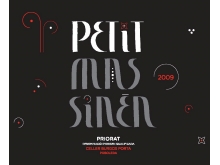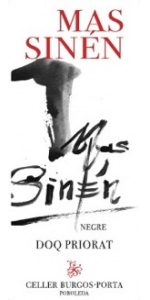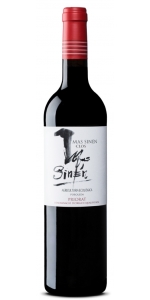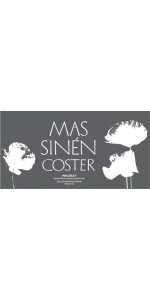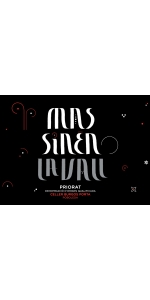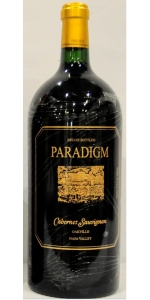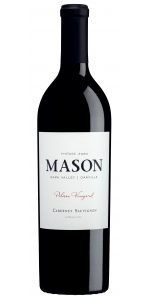Mas Sinen Petit Mas Sinen Priorat 2015
Mas Sinen Negre Priorat is made from 38% Garnacha, 22% Cabernet Sauvignon, 23% Carinena, 16% Syrah
Aged in 90% French, 10% American oak barrels for 12 months.
Maceration for 21 days. ML in stainless steel tanks.
Clarification with white egg and soft filtration.
The wine shows great spice and leather components, some minerality and a lot of ripe red fruits aromas as well.
This wine is certified organic.
Review:
"Dark, bright-rimmed ruby. Highly perfumed, mineral- and smoke-accented red and dark fruit preserve, baking spice and floral pastille aromas, along with hints of licorice and black tea. Gently chewy and focused on the palate, offering juicy cherry, blackberry and spicecake flavors that deepen and turn spicier as the wine opens up. Finishes impressively long and sappy, with a lingering floral nuance, well-integrated tannins and a jolt of smoky minerality. Raised in new and used barrels, 90% French and 10% American.- Josh Raynolds"
- Antonio Galloni's Vinous (March 2021), 93 pts
Mas Sinen Clos Priorat is made from 38% Garnacha, 22% Cabernet Sauvignon, 23% Carinena, 16% Syrah.
Before the 2017 vintage, this wine was called Negre. It is the same vinification and level of excellence as the prior cuvee, but with a different name.
It's quite ripe, concentrated, powerful and oaky with black rather than red fruit and peat and graphite aromas. The palate is full-bodied with plenty of rough-hewn tannins and moderate acidity, and is in need of bottle age and/or powerful food. An XXL Priorat.
Mas Sinen Coster Reserve Priorat is made from 50% Grenache and 50% Carignan.
he Priorat DO was created in 1954. But it is only in the 1990 that the quality of the wines were able to compete internationally. It is now a DOCa (The highest qualification level for a wine region according to Spanish wine regulations, alongside Rioja DOCa). Total acreage for the entire appellation is 4,400 acres. Intense red cherry color with garnet reflections. Black fruit, compote fruits, hints of balsamic. The mouth is ripe and intense, fresh and powerful. Strong and flavorful.
50 year old vines planted on Llicorella soil (decomposed black and reddish Slate, mixed with Mica and Quartz). Light filtration.
Mas Sinen La Vall Priorat is made from 57% Garnacha, 24% Cabernet Sauvignon, 10% Cariñena (Carignan), 9% Syrah.
This wine has a highly intense, lively vermilion red color, complex yet direct aromas with predominant ripe black and red fruits, notes of minerals and forest herbs. Flavors are strong, full and layered with round, fresh and delicate tannins.
Pairs with meat, sausage, cheese.
LASER ETCHED McKenzie ! 5000ml!
My First comment tasting this wine is "wow!" It's delicious; our flagship wine at Paradigm and it delivers. Dense, deep, ripe aromas of black berry and black cherry-like fruit layered with caramel and toastiness from a nice mix of French Oak barrels. Flavors coat the palate with matching notes in a classic Cabernet Sauvignon presentation. One of our best Cabs to date!
Paradigm Cabernet Sauvignon is made from 96% Cabernet Sauvignon, 3% Merlot , 1% Petit Verdot
Review:
"Owned and managed by the Harris family, Paradigm winery produced its first vintage in 1991 in Oakville with winemaker Heidi Barrett. A self-contained winery estate with 50 acres of vineyards, Paradigm maintains a hands-on approach to all winemaking and vineyard operations. The 2015 Cabernet Sauvignon consists of 89% Cabernet Sauvignon, 6% Merlot, 3% Petit Verdot and 2% Cabernet Franc, and is aged in both new and used French oak for 20 months, then aged a further 20 months in bottle before release. The total production for this vintage was 5,544 bottles." Blind tasted by Dave Allen, Stephen Brook, Terry Kandylis (at Decanter Magazine's December 2019 Californian Cabernet 2015 Panel Tasting, London, 17 Sep 2019)
- Decanter 95 Points
Mason Cellars Pelissa Vineyard Cabernet Sauvignon is made from 100 percent Cabernet Sauvignon.
The 2020 Mason Oakville Cabernet Sauvignon is quintessentially Oakville from nose to finish. Attractive fresh blackberry, red current and chocolate with a hint of sweet oak boast out of the glass. This wine showcases graphite, velvety tannins and concentrated, beautifully balanced flavors with a bit of spice and white pepper. These bold flavors typical of Oakville Cabernet are rounded out with velvety tannins, a weighty mid-palate and a long, juicy finish.
Production Notes:
The fruit was delicately hand-picked in the early morning hours and brought into the winery for processing. The grapes were crushed, about 60% whole berry, and cold soaked for three days before being inoculated for primary and malo-lactic fermentation. Once dry, the wine was put down to barrel for 20 months in medium toast French oak, 25% of which was new.
Vineyard Notes:
Grapes for our 2020 Mason Cabernet Sauvignon are sourced exclusively from the Pelissa Vineyard in Oakville. This vineyard spans 60 acres and is planted to Old BV Clone 7 Cabernet Sauvignon as well as Zinfandel. This vineyard is named for Andrew and Babe Pelissa, who after their marriage on August 30, 1930, made their home at the site of this vineyard which, at the time, was a dairy. Oakville is the core of Napa Valley’s famed Cabernet Sauvignon production, and this site is no exception with the flawless blending of climate and soil to create a remarkable wine.
Review:
“This firmly structured, well-balanced wine has the feel of a classic Bordeaux blend. Just-ripe red and black fruits blend with subtle toast, cedar and mint on a moderately tannic, slightly tangy texture. The wine is tasty enough to decant and drink soon with grilled lamb chops or roast chicken. Best from 2026–2036.” – Jim Gordon
-Wine Enthusiast 94 Points
Mas Sinen Priorat Petit Mas Sinen is made from 45% Garnacha, 30% Cariñena (also called Samsó), 10% Cabernet Sauvignon, 10% Syrah, 5% Merlot.
Aged in oak barrels for 6 months.
Maceration for 21 days. ML in stainless steel tanks.
Clarification with white egg and soft filtration.
The wine shows great spice and leather components, some minerality and a lot of ripe red fruits aromas as well.
This wine is certified organic.
"Saturated ruby. Expressive aromas of dark berries, cherry cola, licorice and violet, plus a smoky mineral quality in the background. Sweet, deep-pitched black and blue fruit and floral pastille flavors gain weight as the wine opens up. The long, focused finish shows outstanding clarity and spicy thrust, with velvety tannins framing lingering cherry and floral pastille notes. - Josh Raynolds" - Antonio Galloni's Vinous (March 2021), 90 pts
The Mas Sinen Estate
Mas Sinen is located in the village of Poboleda, in the province of Tarragona. The winery dates back to the 19th century and has been in the family for a few generations. Mas Sinen is a beautiful estate made of stone and surrounded by the family vineyards. Today, Salvador Burgos and his wife Conxita Porta, together with their two daughters, continue the family tradition using the most modern technologies to produce high quality wine from the Priorat Denomination of Origin.
The ancient Mountainous region of Priorat incorporates nine villages of wine production. They are:
- Gratallops
- Bellmunt del Priorat
- Torroja del Priorat
- Poboleda
- Porrera
- La Morera de Montsant
- Escaladei
- La Vilella Alta
- La Vilella Baixa
- El Llorar
- El Molar
The vineyards measure 1.662,55 hectares on size or 4,106.50 acres.
Priorat is about vines per hectare and not about hectares, because the yields are so low.
The name Priorat comes from the word Priory and refers to the 12th century Carthusian Priory established in the region
The old vines in the Priorat region are almost entirely Garnacha and Carignane.
Soil type: local schist called llicorella (decomposing soil type).
Prior to 1979 very few wineries were in production and the area was becoming depopulated. The interest and revolution in Priorat was created by five wineries whose names all began with the word Clos.
1. Clos Mogador - Rene Barber - the modern day pioneer of the region
2. Clos Martinet
3. Clos de L'OBAC
4. Clos Erasmus
5. Clos Dofi - famous winemaker, Rock star and self prom Alvaro Palacios
Today many new small producers with less than 3,000 cases in production are emerging from this area.
Prices for the wines are high and Priorat along with Rioja are the two regions entitled to the highest quality designation by D.O. law: Denominacion de Origen Calificada or DOQ
Today there are 73 wineries in Priorato with new ones coming all the time.
Wines are designed to age for 10-20 years. The styles vary, but Priorat reds are normally dark colored, muscular, tannic, ripe, rich in alcohol in nature Think Chateauneuf-du-Pape from Spain with a Spanish twist.
The Mas Sinen Vineyards
The vineyards measure 15 hectares total. They are planted in terraces, in the slopes of the "Mas Sinen" mountain and are situated 300-500 meters above sea level, cultivated under organic methods. The vines are 5 to 50 years old planted to local schist called llicorella (decomposing soil type) which is typical of the Priorat region.
- back
Holocene The Black Square Cabernet Sauvignon is made from 100 percent Cabernet Sauvignon.
There is something ethereal about Cabernet Sauvignon grown in the cobblestone soils of the Walla Walla Valley. This region offers aromatic exuberance, elegance, finesse, a polished texture, layered complexity, and remarkable length. It is a place where one can craft a singular, stand-alone example of this varietal—unique not only in the United States but worldwide—while still echoing some of our favorite wines from Bordeaux.
In 2022, Winemaker Todd Alexander embarked on a new (yet familiar) journey that he had been patiently awaiting the perfect moment to explore. The Black Square is in its inaugural vintage, and this 2022 is 100% Cabernet Sauvignon grown in the Rocks District of Milton-Freewater, Oregon, which is part of the Walla Walla Valley.
The Black Square embodies elegance and grace framed by great structure, supple texture, and acidity to ensure longevity. It shows ample fruit with complex savory notes. This is not a heavy wine that is monolithic and dull—there are already plenty of those available. This wine offers a unique expression of Cabernet; it may be the most delicious wine Todd Alexander has ever crafted, venturing into new territory for Rocks District Cabernet Sauvignon.
Review:
As black as squid ink, The Black Square is balance personified. A concentrated blackberry aroma seems as dark as the wine's name, with equally dark espresso, olive and charred steak notes joining it in the abyss. A dark plum and ripe boysenberry flavor combo is accompanied by traces of salty Mission olives, wet slate and silky smooth tannins. The one bright feature illuminating the way is the wine's amped-up acidity. None so black
-Wine Enthusiast 98 Points Number 5 in the Top 100
Paul Hobbs George Menini Estate Pinot Noir is made from 100 percent Pinot Noir.
Brilliant ruby red in the glass, the 2022 vintage follows the color with matching aromas of wild mountain strawberry, raspberry, and cherry infused with hints of black tea. On the palate, this wine has the texture of thick satin, evolving seamlessly with subtle energy and pleasant tension. Elegant, fine-grained tannins run through a lingering, juicy finish.
Review:
Wow, a super well-structured, vital wine with oodles of generous black fruit flavors on a firm frame that will help it age well and improve with time. Black cherries, blackberries, blueberries, forest floor nuances and a slight smoky, stemmy character from using mostly Calera-clone grapes, with 15% whole clusters and 30% new French oak. Great interplay between layered fruit and a fresh, crunchy texture. Drinkable now, but best from 2030.
-James Suckling 98 Points & #54 in Top 100

